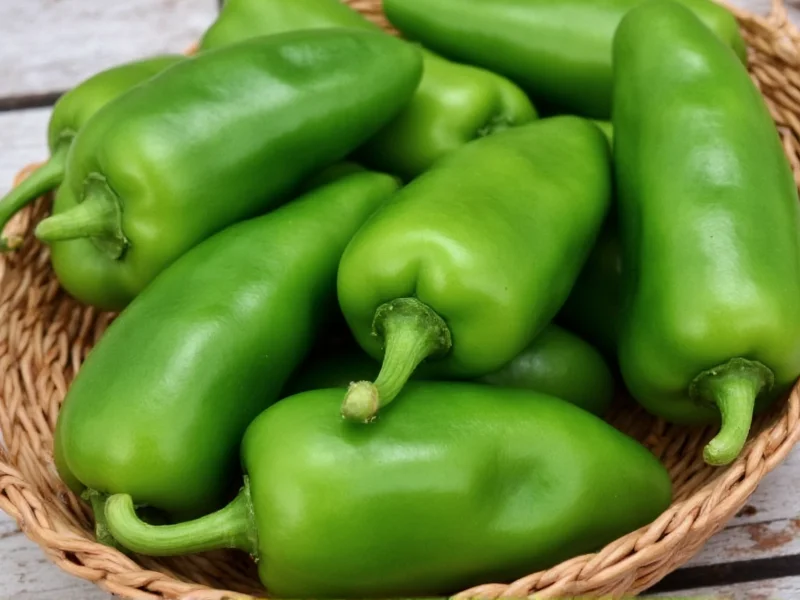Serrano peppers offer a distinctive visual profile that sets them apart from other common chili varieties. Understanding what do serrano peppers look like helps home cooks, gardeners, and food enthusiasts correctly identify these popular peppers in markets and gardens.
Physical Characteristics of Serrano Peppers
When examining serrano peppers up close, several key visual features become apparent. These peppers typically maintain a consistent conical shape with a slightly curved body and a blunt, rounded tip. Unlike some tapered peppers, serranos maintain relatively uniform width throughout most of their length before narrowing toward the stem end.
The skin texture provides another identifying feature. Serrano peppers have remarkably smooth, taut skin with a noticeable glossiness that distinguishes them from the more wrinkled appearance of hotter varieties like habaneros. This smooth texture remains consistent regardless of color stage.
Color Variations Throughout Maturation
Serrano peppers undergo predictable color changes as they mature:
| Maturation Stage | Color | Flavor Profile |
|---|---|---|
| Immature | Bright green | Grassy, fresh heat |
| Maturing | Lighter green to yellow-green | Developing sweetness |
| Mature | Red, orange, brown, or yellow | Fuller, fruitier flavor |
While green serranos dominate supermarket shelves, the mature colored varieties often pack slightly more heat and complex flavor. The color transformation happens gradually, with peppers sometimes showing intermediate shades during transition.
Serrano Peppers vs. Jalapeños: Visual Comparison
Many people confuse serranos with jalapeños due to their similar color range, but several visual differences exist. Understanding how to identify serrano peppers versus jalapeños prevents recipe mishaps since serranos run 2-4 times hotter.
The most reliable visual differentiators include:
- Size: Serranos average 1-4 inches long, while jalapeños typically reach 2-4 inches
- Shape: Serranos maintain a slender, straighter profile with consistent width; jalapeños have a more bulbous middle section
- Wall thickness: Serranos have noticeably thinner walls, making them less suitable for stuffing
- Stem appearance: Serrano stems appear more delicate with a subtle curve
Practical Identification Guide
When shopping for serrano peppers, look for specimens with vibrant color and firm texture. High-quality serranos feel heavy for their size with taut, unblemished skin. Avoid peppers with wrinkles, soft spots, or discoloration, which indicate age or damage.
Grocery store displays often mix similar-looking peppers, so checking multiple visual characteristics prevents misidentification. Remember that serrano pepper appearance remains consistent across varieties, though some cultivars may show slight variations in curvature or final color.
Growing Conditions and Visual Impact
Environmental factors influence serrano pepper appearance. Plants grown in optimal conditions produce straighter, more uniform peppers with consistent coloration. Stress factors like inconsistent watering or temperature fluctuations can cause slight curvature variations or irregular color patterns.
Home gardeners should note that serrano plants typically grow 24-36 inches tall with dark green foliage. The peppers initially appear green and gradually change color as they mature on the plant. Understanding these growth patterns helps identify serrano plants before harvest.
Common Misidentifications
Several peppers commonly get mistaken for serranos:
- Fresno peppers: Nearly identical shape but slightly larger with thicker walls
- Thai chilis: Much smaller (1-2 inches) with a more pronounced curve
- Red jalapeños: Often confused when serranos mature to red
The most reliable way to confirm what serrano peppers look like involves examining multiple characteristics rather than relying on a single feature. Combining size assessment, shape analysis, and wall thickness evaluation provides the most accurate identification.
Using Serrano Peppers in Culinary Applications
Once properly identified, serrano peppers work well in various culinary applications. Their thin walls make them ideal for slicing into salsas, pickling, or adding raw heat to dishes. Unlike thicker-walled peppers, serranos don't require roasting to achieve optimal flavor release.
Chefs appreciate serranos' consistent heat level and clean pepper flavor that enhances dishes without overwhelming other ingredients. When substituting in recipes, remember that serranos deliver more intense heat than jalapeños, so adjust quantities accordingly.
How can you tell the difference between a serrano and a jalapeño by appearance?
Serrano peppers are noticeably smaller and more slender than jalapeños, typically measuring 1-4 inches long compared to jalapeños' 2-4 inches. Serranos maintain a consistent width throughout their length with thinner walls, while jalapeños have a more bulbous middle section and thicker walls. Serranos also feature a more pronounced conical shape with a blunt tip.
Do serrano peppers change color as they mature?
Yes, serrano peppers change color significantly as they mature. They start as bright green when immature, then transition through lighter green and yellow-green stages before reaching their final color of red, orange, brown, or yellow when fully mature. The color transformation happens gradually, with peppers sometimes showing intermediate shades during the transition period.
What is the typical size of a serrano pepper?
Serrano peppers typically measure between 1-4 inches (2.5-10 cm) in length. They have a diameter of approximately 0.5-0.75 inches (1.3-1.9 cm) at their widest point. Their size makes them noticeably smaller than jalapeños but larger than Thai chilis. The consistent size range helps with visual identification when distinguishing serranos from similar pepper varieties.
Are serrano peppers always green?
No, serrano peppers are not always green. While they appear bright green when immature and most commonly found in this stage at grocery stores, they ripen to various colors including red, orange, brown, or yellow. The mature colored varieties often have slightly more heat and complex flavor than their green counterparts, though the visual differences don't significantly alter their culinary uses.
What does the skin of a serrano pepper look like?
Serrano peppers have remarkably smooth, taut skin with a noticeable glossiness. Unlike hotter varieties like habaneros that develop wrinkles as they mature, serranos maintain their smooth texture throughout all maturation stages. This glossy, unwrinkled appearance is one of the key visual characteristics that helps identify serrano peppers and distinguish them from other chili varieties.











 浙公网安备
33010002000092号
浙公网安备
33010002000092号 浙B2-20120091-4
浙B2-20120091-4